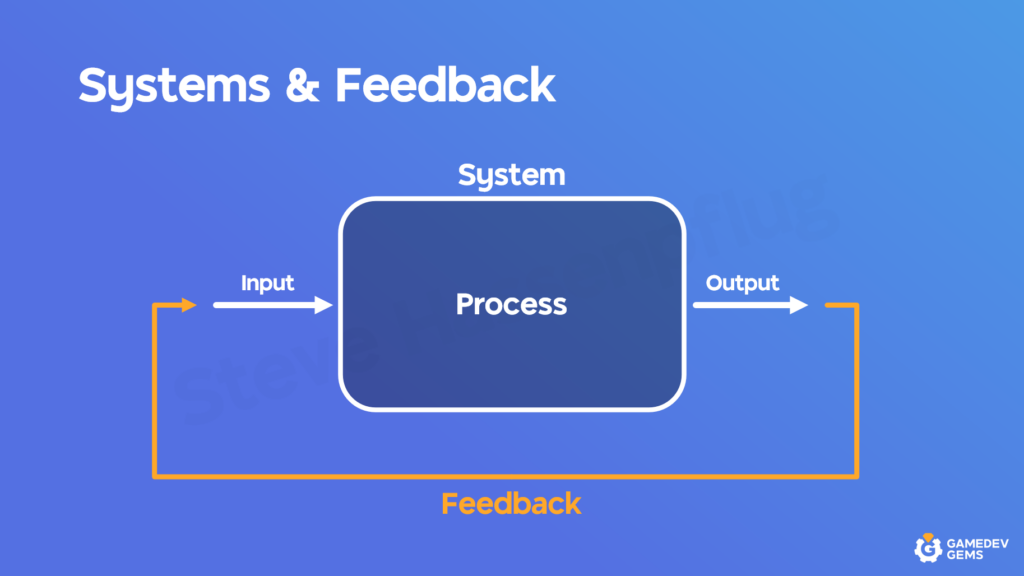
Overview
There are only a few concepts in life that once you understand them, they change how you view the world – and the idea of feedback loops is one of them. They are in-fact so prevalent that you will see them everywhere you look – in video games, in society and even in yourself – that’s because they are that universal.
Harnessing their power gives you the ability to identify and solve all sorts of problems, especially in game development. What does the Blue Shell of Mario Kart and your body temperature have in common with feedback loops? Let’s find out!
You, the Feedback Loop
Did you know you are actually a feedback loop yourself? Our bodies internally regulate our health – if you go outside when it’s cold, your internal body temperature drops and you will begin to shiver – a similar effect occurs if you go out on a hot day and start to sweat. Your body is trying to keep you at the optimal operating temperature at all times. This process of thermoregulation is a feedback loop that’s built right into you!

There’s tons of other examples of feedback loops. For example, draw a scribble of a cat. Now, draw another cat. You will have learned something about how to draw a cat in the process. The next time you will be ever-so-slightly better at drawing a cat. Keep on doing it, and you will get better in the process. That’s a feedback loop.
Systems & Feedback
Now that we have a rough idea on what feedback is, we need to define what a system is and how feedback relates to it before we can apply it to game development:

A system is a set of procedures (called the process). Input (an action – such as a player defeating an enemy or someone using their pencil to scribble) is processed, and some result is then being output – for example a player getting a reward in a video game or someone having drawn a picture of a cat.
The key concept is now that if the output feeds back into the input of the same system, we have a feedback loop – otherwise we simply have a system. In the two examples that means getting more rewards and having learned something about drawing – likely resulting in a “better” picture of a cat.
There’s actually two different types of feedback: Positive and negative feedback, so let’s break them down one by one.
Positive Feedback Loops
A positive feedback loop is a type of feedback loop where the initial input leads to a response that is amplifying. This amplifying response then causes further changes that reinforce the initial change, leading to a self-reinforcing cycle. The end result is growth (or decline!) away from the initial change, and a deviation from equilibrium.

It’s important to understand that the term positive refers to amplification of an effect only and does not necessarily mean it’s a good outcome! This is a crucial aspect of feedback loops that many people (and a LOT of game developers!) get wrong all the time.
In simpler words, if a thing happens it is much more likely to happen again. For example successes lead to more successes and failures lead to more failures, e.g. a Snowball Effect occurs.
Imagine a game of Chess: Carelessly losing a piece (usually) increases the chance for losing another piece, as you have less power and options available to you – which lead to further losses – thus the negative outcome is amplified when losing chess pieces – it’s a positive feedback loop with a negative effect!
Negative Feedback Loops
On the other hand, a negative feedback loop is a type of feedback loop where the initial input leads to a response that dampens the effect – it counteracts the initial change. This response then causes further changes that oppose the initial change, leading to a self-regulating cycle. The end result is a stabilization of the system or a return towards equilibrium.

Again, negative in this context does not mean the outcome will be bad – it may actually result in something that’s much more fun for everyone involved! Such as in a Mario Kart match, which we’ll explore below.
Feedback Loops in Games
I’d argue that feedback loops are found in almost every game in existence, barring a few experimental ones. The most prevalent one is the so-called compulsion loop:
Compulsion Loops (Core Loops)
A compulsion loop (also often called core loop) is a specific type of positive feedback loop and represents a habitual chain of actions that are repeated by players to cause them to continue a given activity. It’s one of the main reasons on why you continue playing certain games, even though you can’t entirely explain why. It’s fun but can also be addicting. Most core loops in video games are designed around extrinsic motivation for players, which gives them a dopamine rush.

Take your average RPG for example: Kill enemies, get stronger, kill more enemies faster, get even stronger. That’s a basic core loop – a positive feedback loop, with a positive outcome.
Of course most games counter-act this amplification in power with a myriad of additional game systems, such as leveling system, scaling enemy power, reducing XP gain as the player gets stronger, etc. – all to create compelling compulsion loops that keep you playing and keep you coming back.
Mario Kart: The Blue Shell & Rubber Banding
Arguably the best-known example of a negative feedback loop in video games is a set of hidden game mechanics in Mario Kart that has been dubbed “rubber banding”:

- Players in higher places get progressively less powerful items (The player in the first place gets the least powerful items).
- Additionally, the intelligence of the AI opponents changes in real-time depending on the player’s absolute position, amplifying the rubber banding effect. (The further a player is behind the AI, the less capable the AI will be).
This results in a so-called rubber banding mechanic where good players are punished and bad players are rewarded – the goal of this mechanic ultimately being to keep games interesting by making sure victory is within grasp for all players, no matter their skill level. This is essentially a form of Dynamic Difficulty Adjustment which ultimately seeks equilibrium, hence it’s a negative feedback loop.
Note that if spotted by players this mechanic can feel like that the game or AI is unfair or cheating or that playing well is discouraged – it’s up to you as a designer to make sure that players still strive to play to their best ability and don’t resort to techniques or play patters that makes the game less enjoyable in the long run.
Games without Feedback Loops?
While feedback loops are found in virtually every modern game, it’s important to note that not all games have (or need!) feedback loops – at least not for every system or feature within.
Take a fighting game like Street Fighter or Tekken for example – these games specifically refrain from making use of feedback loops in their core combat systems. Dealing damage to the opponent or winning a round gives players no mechanical advantage (such as dealing more or less damage) – failures or successes don’t impact (or feed into) subsequent ones – even if you took 99% damage and have one pixel of health left, technically you still have the same (mechanical!) chances to win, given you would play perfectly. In real life, player emotions and play dynamics play a big role in this and adrenaline will likely keep you from playing flawlessly though.
Exceptions exist of course:
Keep in mind that games can and do contain multiple loops, and in-fact even most fighting games have many additional loops – such as meta game systems, for example earning resources to purchase vanity items or earning ranking points to get stronger opponents.
Conclusion
In this article we’ve learned what feedback loops are and how they relate to systems. We’ve also explored the two different kinds of feedback, positive and negative loops, which amplify their outcomes or dampen them.
In summary, positive feedback loops amplify changes and can create instability, whereas negative feedback loops stabilize systems and return them to equilibrium.
Ultimately it’s up to you as the game designer to determine if, where and how you will use feedback loops to your advantage – think about what you want players to experience. In any case, you know have the knowledge to spot and think about these system in all aspects of life and game development!
In a future article I will talk about how you can use feedback loops to design compelling game systems as well as practical case studies. I’ll also explain in-depth how feedback loops can be mixed-and-matched to determine the whole pacing of a game – keeping players excited as long as possible and ending matches quickly should they drawing out for too long.
If that sounds interesting, please subscribe to the GameDevGems YouTube channel! Did you learn something new? How would you apply feedback loops in your game? Let us know by joining our ever-growing GameDevGems Discord Community!
About the Author

Written by Steve Haßenpflug, a seasoned game designer with a strong product & technical background. His focus is on creating engaging games for companies who want big results. GameDevGems is a passion-project of him.
Steve has developed top-grossing AAA games for IPs beloved by players around the world (Angry Birds, XCOM, Trolls) with international companies (2K Games, NBC Universal, DreamWorks, Rovio) and helped bootstrap gaming startups in the early stages of seeding.
He’s an expert in mobile free-to-play mechanics and is currently focused on bringing web3 game development and blockchain technology together at ChromaWay.

Pingback: Game Balance 101: 5 ways You should balance your Game - GameDev Gems
Pingback: Dynamic Reward Systems: Design Games like a Pro in 2023 - GameDev Gems